Jaisyn’s room is tucked quietly toward the back of his house. There is a large picture of Jaisyn, dressed in his football gear and an infectious smile, hanging on the wall. Star Wars items dot his shelves, including a fully functioning light saber. Taekwondo awards show his dedication and skill and his black belt achievement. It’s such a warm and inviting space, a teenager’s true sanctuary. It was Jaisyn’s favorite place to be – home. It was where he was able to spend his last moments with his precious family and where they continue to spend time – feeling a bit closer to him in his beloved space.
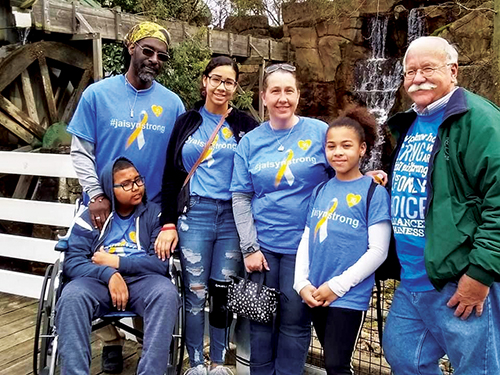 When an active young kid, especially a jokester like Jaisyn, complains of odd changes, it’s easy to explain them away. It was December 2019 when Jaisyn Reese began complaining about left-sided face numbness. “’Mom, I can’t feel my face,’” Angie, Jaisyn’s mother recalled him saying. “Well, that’s weird,” she responded. “We’ll keep an eye on it.” Then he complained about his eyes crossing and it was easy to just dismiss it as his silly way to make his family laugh. But when the symptoms continued to worsen throughout the month, it was evident something more was going on. As concerns about COVID-19 increased, they asked if that was causing his issues. It wasn’t that. Later, during a school day, Jaisyn called his mom and told her he almost fell down the stairs. “I’m dizzy and I have a headache,” Angie recalled him saying. She picked him up from school and took him to the doctor. He scheduled an MRI and Angie remembered him saying, “He could have migraines, he could have a viral infection or worst case, it could be a tumor.” A few days later, while they waited for the MRI, Jaisyn began vomiting and his headache worsened. Although she was already dressed for work, Angie’s boss encouraged her to take Jaisyn in right away instead of waiting for the scheduled MRI. She headed to Bremen, and after much encouragement, his MRI was transferred there. Angie sat alone with Jaisyn while she heard the news. There’s no preparation for such news. Our minds don’t land on the worst-case scenario initially, and this was not the first time Jaisyn had been to the ER. “There is a mass,” the doctor said. Angie looked at him, and the tears began.
When an active young kid, especially a jokester like Jaisyn, complains of odd changes, it’s easy to explain them away. It was December 2019 when Jaisyn Reese began complaining about left-sided face numbness. “’Mom, I can’t feel my face,’” Angie, Jaisyn’s mother recalled him saying. “Well, that’s weird,” she responded. “We’ll keep an eye on it.” Then he complained about his eyes crossing and it was easy to just dismiss it as his silly way to make his family laugh. But when the symptoms continued to worsen throughout the month, it was evident something more was going on. As concerns about COVID-19 increased, they asked if that was causing his issues. It wasn’t that. Later, during a school day, Jaisyn called his mom and told her he almost fell down the stairs. “I’m dizzy and I have a headache,” Angie recalled him saying. She picked him up from school and took him to the doctor. He scheduled an MRI and Angie remembered him saying, “He could have migraines, he could have a viral infection or worst case, it could be a tumor.” A few days later, while they waited for the MRI, Jaisyn began vomiting and his headache worsened. Although she was already dressed for work, Angie’s boss encouraged her to take Jaisyn in right away instead of waiting for the scheduled MRI. She headed to Bremen, and after much encouragement, his MRI was transferred there. Angie sat alone with Jaisyn while she heard the news. There’s no preparation for such news. Our minds don’t land on the worst-case scenario initially, and this was not the first time Jaisyn had been to the ER. “There is a mass,” the doctor said. Angie looked at him, and the tears began.
Jaisyn was eventually diagnosed with DIPG, diffuse intrinsic pontine glioma. According to St. Jude Children’s Research Hospital, “DIPG is a type of tumor that starts in the brain stem, the part of the brain just above the back of the neck and connected to the spine. The brain stem controls breathing, heart rate and the nerves and muscles that help us see, hear, walk, talk and eat. These tumors are called gliomas because they grow from glial cells, a type of supportive cell in the brain.” Symptoms of DIPG include problems with balance and walking, nausea and vomiting, headaches and problems with the eyes — all of which Jaisyn experienced. Treatment is radiation and sometimes chemotherapy. Surgery can be done for biopsy, but surgery to remove the tumor is very rare. “Unfortunately, the survival rate for DIPG remains very low. At this time there is no cure for this tumor,” St. Jude noted.
Life for the Reese family changed drastically – living out of suitcases, driving across states and filling their schedules with medical appointments that replaced the previous busyness of school and extra-curricular activities. “Two days before we were supposed to go back down to Indy, St. Jude’s called,” Angie said. “We talked with the doctors there, and they said they wanted to take him, but we had to do radiation there.” They arrived at St. Jude’s the end of January 2020. After a 10-hour drive, they got there at 7pm and were assigned a navigator to show them around. “It was so overwhelming,” Angie remembered. “I cried the entire time we were there.” They soon realized that they would be staying there for the duration of his radiation – six weeks. The Reese family was thoroughly appreciative that they could stay in a suite together – Angie, Emanuel (Jaisyn’s father), Angie’s father and Jaisyn. Everything, including meals, was covered. Touring St. Jude’s made a deep impression on Angie. “There were kids from all countries … everywhere,” she said. “The thing was … they were smiling. Everyone in their lifetime should walk into that hospital.”
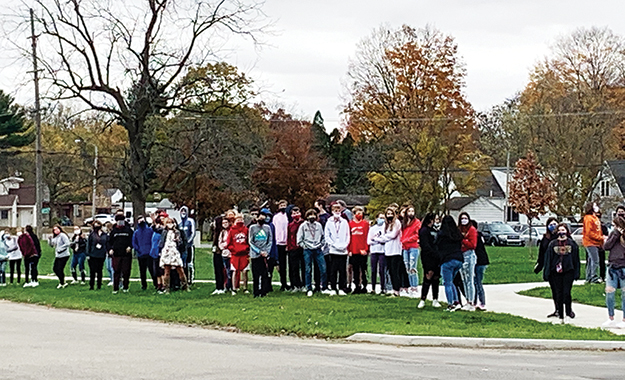
Fellow students at Lincoln School line up outside the school to welcome Jaisyn home after spending time at St. Jude’s and Memorial Hospital.
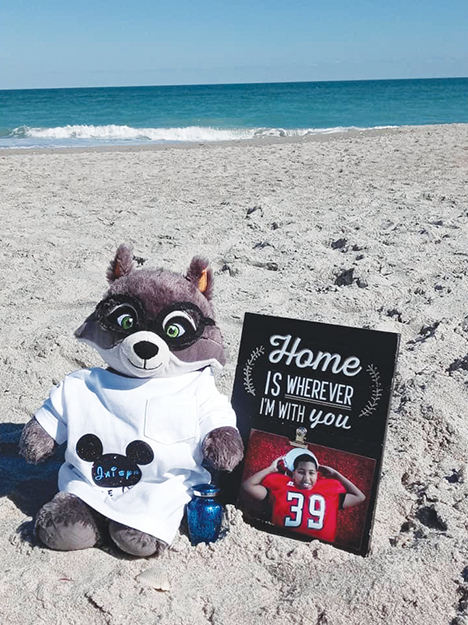
Part of the grief journey for Jaisyn’s family is continuing to make him a part of their everyday lives.
Jaisyn finished radiation and returned home at the end of March. His school filled the yard with signs. Trials typically start 8-12 weeks after radiation, so Jaisyn was home for a while until he was able to start a trial. In the meantime, the family decided to start services with Center for Hospice Care in April 2020. Dr. Matthew Misner, Center for Hospice Care’s pediatrician, along with our team of dedicated nurses, social workers, chaplains, counselors and volunteers are committed to providing care with exceptional compassion and empathy to pediatric patients and their families. “The truth of the matter is,” Dr. Matt said, “I want to be succeeding all the way through. Not just at the end.” Misner shared more about their ability to collaborate with St. Jude’s as they joined forces to provide the best care for Jaisyn. “Brainstorming … I feel like there are still organizations where [care] is primarily physician driven. There is room for my experience, but I always know in the back of my head I’m not infallible.” A team approach makes hospice care stronger, and strong support is absolutely vital for pediatric hospice families. Kathy Eash, a CHC nurse practitioner, loves being part of Center for Hospice Care’s pediatric team, “Our team just pulls together so well for children. It always feels like an honor to be part of this group.” Tiffany Herr, a CHC nurse, recalls pulling together for Jaisyn’s sake, “We went up to Memorial a couple of times to figure out how we were going to keep our services in line with Memorial, St. Jude’s and the family. It was a bunch of connections across states to figure out what we could do.” Stacy was another CHC nurse that cared for Jaisyn. “I love Stacy,” Angie said. “She is the one I confided in.”
Jaisyn was approved for a trial and scheduled to leave for Memphis on May 4th. Unfortunately, by this time, COVID had shut down much of the country. Because of this, Angie and Jaisyn would have to go by themselves and stay there for an entire month. Before they left, his school, community and church sent him off with a drive-by parade. “They did this whole drive-by parade the day before we left, which was really good for him,” Angie shared. When they arrived, they were told they couldn’t start the trial for a couple weeks while they weaned him off the steroids. This disappointed Jaisyn; he could have spent more time at home. “He just didn’t want to be away from home,” his mom said. “To him it was more about quality of life. He was a homebody and wanted to be with his family and his friends.” When his month was finished and he knew he was heading home again, Jaisyn was on the couch by 2:00am ready to go.
The summer was filled with a lot of swimming. “Anytime he wanted to go swimming, he went swimming,” Angie shared. “He was just swimming away, like nothing was even wrong with him.” Make-a-Wish was contacted and Jaisyn really wanted a trip to Disney. “They had all of that planned for us after radiation in April. The plane tickets were bought, and everything was set, but they couldn’t do it because of COVID.” Jaisyn had to come up with another wish. He didn’t want a shopping spree – he didn’t want “things.” He wanted experiences. Make-a-Wish ended up buying him a camper, which they used to stay at Horn Lake in Mississippi, about 15 minutes from St. Jude’s.
While the family was doing their best to fill every moment with experiences and life, DIPG was an annoying sidekick, inserting itself with painful symptoms and frequent blood work appointments. Jaisyn’s desire to be with family and to fight was evident in how he faced his treatments. “He did all of his MRIs and all of his radiation non-sedated,” his mom glowed proudly. “He knew the risk of being put to sleep and being sedated. There was a huge risk because of the tumor that he would not come out of it. He didn’t want to do that… I was so proud of him.”
Much of the support that the family received was from fellow families in similar situations. They met many people who are friends to this day. One of those was a Facebook friend who Angie eventually met in person outside the hospital one day. She spoke to Angie moments before they had to take her son off a ventilator. He had been fighting for a couple years. She told Angie, “I’m going to go in here with grace and do what God needs me to do.” Angie remembered these words, wondering how the woman ever had the strength to do that. Angie thanked her for those words right before Jaisyn died.
Jaisyn had a wonderful support system and they worked tirelessly to fight for his life. As the disease progressed, his symptoms worsened and while traveling between states to continue his care, Jaisyn had to be airlifted to a hospital. During his last MRI the doctor told them that the tumor had started to bleed. “We looked at each other,” his mom recalled, “and said we want to go home. They made it possible.” He spent a week in Memorial Hospital in South Bend, but Jaisyn was glad he was near home. After a week at Memorial, he was cleared to leave, but an additional stop was orchestrated on his way home through a group effort. Sarah Sieh, a social worker at Center for Hospice Care, was part of the team who planned a special stop for Jaisyn. “He wanted to see friends, so I talked with his mom, and we set up a wheelchair ride home,” Sarah explained. “We asked if Tri-County Ambulance could drive by Lincoln School so he could see his friends before going home. The kids came out. The police officer, Bridget, that works with the school, did a police escort. The kids were outside waving.” The schools all got involved and even delayed the time for the end of the day release. The high school also released students about the same time Jaisyn came through; they didn’t want anything interrupting his stop.
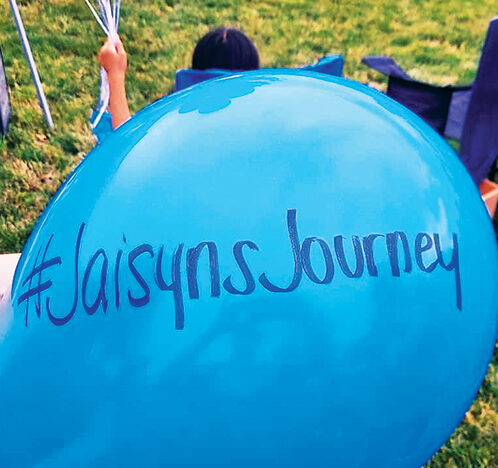
“I remember his mom doing such a fantastic job of pursuing his care,” Eash, a CHC nurse practitioner, reflected. “I wanted to be the one to take care of him,” Angie said. “That’s what I did for a living, and I wanted to do it as long as I could.” The time came when she was so weary, she called for extra help. “At 4:00am I called and said I can’t do it anymore,” Angie remembered. “I need you to come. Tiffany and Stacy were here all day, until the end.” The morning that Jaisyn died the family took pictures and did Christmas early; it was incredibly difficult. Jaisyn was lovingly surrounded by those he treasured most: his mom, dad, and his sisters, Karrissa and Trisha.
When people lose a loved one, comfort and support typically surround the family for a few weeks. Meals and cards and loving words usher the family into their time of grief. Then things go quiet. There are no more visits. It seems as if those outside the family return to normal. For the families in grief, time has stopped. Watching others move quickly from activity to activity, life goes on… for others. Support is still needed, a month later, a half a year later and longer. But what is meaningful to bereaved parents? “Say their name,” Angie shared. “Let me talk about him. I have to be able to talk about my son.” Angie works with older adults, some of which have dementia. She cares for them. There is one lady she talks to daily about Jaisyn and the woman hugs Angie. “That is what I’ve needed.”
It’s also about incorporating Jaisyn into life daily. The Reese family has a digital photo frame with changing pictures and videos. Hearing his voice and seeing his face is comforting. It’s being able to continue the relationship. This year, on his birthday, his mother helped organize an event at his school. They did a balloon launch which Sarah Sieh and Tiffany Herr attended. “They were writing ‘Jaisyn’s Journey’ on the balloons. People talked and the pastor shared and did a prayer. Then they did the balloon release.”
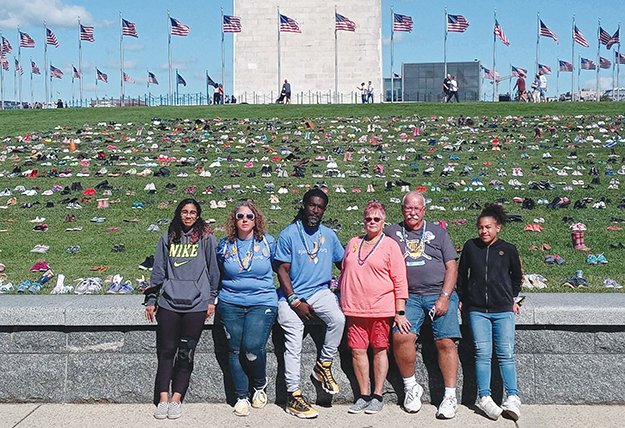
It’s also about coming alongside others on this journey, too. This fall the Reese family attended a DIPG breakfast in Washington, D.C. They heard from doctors and researchers and a few warriors still fighting. “Later that day we rallied the Capitol with our signs,” Angie explained. “That night there was a candlelight vigil where we went on stage as families and said our children’s names. On Sunday there was a Shoe Memorial at the Washington Monument. Bereaved families placed their children’s shoes on the grass. Most were DIPG families. The 1,800 shoes represent the 1,800 children who die of cancer every year.” Jaisyn’s Journey will continue because he has loved ones who carry his story with them… every day.
And if you see his family, say his name, ask about him
and let them share about Jaisyn… the mighty warrior.
